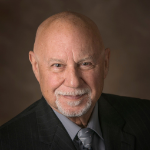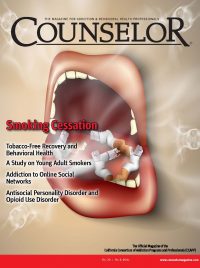Share
Many crimes are committed by individuals with antisocial personality disorder (ASPD), and ASPD and substance use disorders (SUDs) can be a deadly combination. As one often accompanies the other, differential diagnosis is an essential precursor to the treatment process. Differential diagnosis is particularly difficult for two reasons: first, the abuse of substances (legal or illegal) is common among individuals with ASPD, and second, alcohol and drug users often exhibit antisocial behavior that is secondary to their basic problem.
Psychopathy, which can be defined as a personality trait factor characterized by of lack of empathy, lack of remorse or guilt, grandiosity, superficiality, compulsive lying, shallow affect, and manipulation and conning (Hoffman, Rippon, & Watt, 2018), is associated with the diagnostic category of ASPD in the fifth edition of the Diagnostic and Statistical Mental of Mental Disorders (DSM-5; APA, 2013). While it is true that not all people given the diagnosis of ASPD are psychopathic, there are many overlying factors between the two groups. It was once posited that psychopathy was rare; however, today psychopathy is regarded as quite common. Individuals with high levels of psychopathy can be divided broadly into two categories:
- Successful individuals with psychopathy often found in boardrooms
- Individuals with psychopathy commonly seen in the criminal justice system
In order to make the distinction between ASPD and SUDs, it is necessary to view the clinical picture of each, as well as explore how substance use and abuse contributes to crime. This article will discuss the following:
- The clinical picture of individuals with SUDs
- The clinical picture of individuals with APD
- The contribution of substance use/abuse to crime
- Differential diagnoses
A Psychodynamic Clinical Picture of SUDs
Psychodynamic theory offers one helpful model of conceptualizing SUDs. In fact, other popular counseling theories are to some extent rooted in psychodynamic theory. For example, cognitive behavioral therapy (CBT) theorists have credited the influence of psychodynamic training in the development of CBT’s concepts of schemas and core beliefs, both conscious and unconscious, which are in part rooted in early developmental experiences, such as interactions with primary caregivers (Beck, 2011; Vernon & Doyle, 2018). In this theoretical model, substance use and abuse originate in the narcissistic stage of psychosocial development. At about the age of two, these children see themselves as the most important people in the world. From the objectless stage of development in infancy, they now begin to differentiate themselves from their mothers and fix their interests almost entirely upon themselves. At about three or four years old, this narcissistic or self-loved stage reaches its apex. The children then begin to expand their interest in friends, teachers, and others, and they express these interests from themselves to others.
An upheaval of the narcissistic stage is seen at puberty. Due to the numerous physiological changes now taking place, the adolescents become once again preoccupied with self. This is the stage of development where they become the most vulnerable to externalizations such as substance use. They are most vulnerable, as they are at the height of elation or the depth of despair—they feel either utterly hopeless or extremely enthusiastic. They may have burning or sterile intellectual or philosophical preoccupations. There is a yearning for freedom, yet there is a sense of loneliness. There are feelings of oppression by parents and impotent rages or acts of hate directed against the adult world. At this time, we see erotic crushes and suicidal fantasies. As Anna Freud said, “Adolescence is by its nature an interruption of peaceful growth, and
. . . the upholding of a steady equilibrium during the adolescent process is in itself abnormal” (1958, p. 273).
Little is known regarding the dynamic features of the psychopathology of SUDs, however, certain early developmental milestones seem congruent with this disorder. There are usually absent or weak fathers with overprotective, overindulgent, domineering mothers. There is often no definition of limits set upon these children and a bombardment of inconsistent,
double-level messages. There is a tremendous amount of hostility and conflict between parents who make unrealistic demands on their children. The development of such a disorder is due to the loss of maternal nurturing and subsequent development of an ego defect accompanied by an intrapersonal belief that these individuals are worthless and unlovable.
These individuals are narcissistically frustrated by disappointment and disillusionment. They feel betrayed and humiliated by their schizophrenogenic mothers, with whom their ambivalence becomes further distorted. Frustrated by their absent and weak fathers, their self-esteem becomes injured through excessive overevaluation of self, rage, shame, envy, and loneliness—with no place to go, they internalize these emotions. This internalization of anger, therefore, becomes a learned behavior that forms a pathological repetition compulsion, reinforcing their view of themselves as worthless and sinful. They then become extremely vulnerable to the abuse of substances as a narcissistic demand for self-worth. Through substance use and abuse they can at least temporarily feel confident and free from anxiety. This delusion may manifest itself on and off for many years, until the deleterious effect of the abuse takes its toll.
The Correlation of SUDs and Crime
Due to previous exploration in the social pathology of crime, it is apparent that intoxication seems to be a significant catalyst necessary for criminals to act out violent crimes. There is evidence that supports the hypothesis that substance use/abuse plays a tremendous part in eliciting criminal acts, because during intoxication individuals’ resistance to criminal-genetic impulses is reduced. For example, Bronson, Stroop, Zimmer, and Berzofsky reported increased substance use and abuse amongst criminals, indicating:
More than half (58 percent) of state prisoners and two-thirds (63 percent) of sentenced jail inmates met the criteria for drug dependence or abuse, according to data collected through the 2007 and 2008–09 National Inmate Surveys (NIS) . . . In comparison, approximately 5 percent of the total general population age eighteen or older met the criteria for drug dependence or abuse (2017).
According to the “No Safe Haven” report published by the National Center on Addiction and Substance Abuse at Columbia University (CASA), parental behaviors most predictive of antisocial outcomes for children include arrests, chronic unemployment, desertion, excessive drinking, and failure to support, indicating:
A devastating tornado of substance abuse and addiction is tearing through the nation’s child welfare and family court systems leaving in its path a wreckage of abused and neglected children, turning social welfare agencies and courts on their heads, and uprooting the traditional disposition to keep children with their natural parents (1999).
Cloninger and Guze (1970) studied sixty-six females convicted of felonies, 65 percent of whom met the diagnostic criteria for sociopathy. Such sociopathy was associated with other diagnostic categories, namely alcoholism (60 percent) and drug dependency (30 percent). Individuals with personality disorders excessively use legal and illegal substances, and this is especially true for those with ASPD. The number of work hours lost in business, industry, and other professions each year because of substance use is staggering. In addition to its effects on those who use these substances, substance use/abuse often poses hardship and suffering among the families, work associates, and friends of users.
Substance use and abuse is common in individuals with ASPD when they find their impulses and desires persistently blocked by circumstances. Persons with ASPD may also use substances as a way of defying their families and the standards of society that condemn the excess use and abuse of substances.
It is the feeling of this author that when certain antisocial personality traits are predominant in individuals, these personality traits make them vulnerable to their own antisocial inclinations when substances are introduced. That is, alcohol reduces the ability for individuals to control their impulses and makes them vulnerable to act out their innate and unresolved rage in the form of criminal behavior.
Besides pronounced narcissism and pleasure-seeking reflecting an infantile fixation, there are two other elements that give criminals of the neurotic character type a special quality: the means of satisfying their sex drives and their indulgence in substance use/abuse. Many individuals with SUDs suffering from disturbed personality disorders may commit crimes while imbibing or while intoxicated. Frequently, individuals using substances and engaging in criminal acts manifest character disturbances, although substances are also often found in those suffering from character disorders or psychosis, especially in the form of schizophrenia.
The Emotional Cause of Narcotic Addiction
The emotional turmoil of various severe personality problems may contribute to narcotic addiction. Individuals with opioid use disorder (OUD) often have profound anxiety and marked feelings of insecurity and inadequacy. They find relief from these painful feelings in the sedative effects and sensations of well-being that narcotics give them. Some individuals with OUD have, in addition, severe ASPD, and the personality problems discussed in the preceding section on ASPD are present in them. These types of individuals have a defective sense of guilt and social responsibility, and they tolerate frustration of their impulses and desires poorly. They are unable to engage in warm, meaningful, interpersonal relationships, and they have a profound self-centeredness in which people are merely objects that serve their needs or frustrate them. They do not modify their behaviors because of punishment or failure, and they have little perception of the feelings and rights of others and the demands of society. They proceed from one impulse to another without consideration of the long-range results of their acts.
In childhood, individuals with OUD usually have traumatic relationships with both parents and with other close people; in most cases they did not have a sound, affectionate relationship with any adult. They did not form healthy identifications with any others, and they often emerge from childhood and early adolescence with profound hostilities that cause them to rebel wildly against their parents and against social conformity. Their narcotic addiction and the criminal activities into which it leads them serve as a flagrant means of defying the standards and ethics of society. Narcotic addiction tends to be more common among individuals in socially deprived groups; in addition to disorganized family lives, they are damaged by the poverty, cultural neglect, and racial discrimination in which they were reared and are still living. For them, opioid use is a way of rebelling against both their families and the social system they hate. However, beneath their belligerent defiance many individuals with OUD have anxious cravings to be cared for in childlike ways. Because their bodies need more of the drug, the dosage must be increased. In a psychological sense, they become reduced to the status of infants, who can only receive and never give. They regress to an extreme stage of passive orality, during which their only concern is to satisfy their need for the drug.
In view of the different degrees of antisocial development in people’s characters, it is understandable that we find tremendous diversity among those committing crimes. It is therefore not surprising that these individuals have been lumped together into one category described as “psychopathy.” This term has been used so much historically that if individuals’ conditions could not be diagnosed properly, they were labeled “psychopaths.” Such a description has hampered both diagnosis and treatment of many people who otherwise could have been helped if a proper diagnosis had been made.
For example, individuals committing sexual crimes have often historically been labeled as “sexual psychopaths.” When we began to study sex offenders in Sing Sing Prison, we found that most of those who had been previously labeled “psychopaths” were instead people with symptoms reflecting conditions of neuroses, psychoses, reactive alcoholism, and character disorders. Of the 102 sex offenders examined via careful psychiatric-psychological examinations, twenty-five revealed distinct disturbances of character (Abrahamsen, 1960). Due to overuse of these terms, we finally had to discard the terms “psychopath” and “sexual psychopath.” This author’s personal conclusion is that the only offenders who can be called “psychopaths” are the genuinely psychopathic offenders.
The diagnosis of genuine psychopaths can only be reached after excluding all other psychiatric conditions. Genuine psychopaths are exceedingly narcissistic and impulsive. They are not neurotic, psychotic, or mentally defective, but they do show a pronounced absence of guilt and anxiety. They have been unable to establish any emotional relationships with others and are asocial and amoral. Since they are orally fixated, they are infantile in their emotional and behavioral manifestations and show a polymorphic type of sexual behavior—they can be heterosexual, bisexual, or homosexual. They differ from people with character disorders in that they have not developed any superego structure, while offenders with character disorders have developed some, however weak. The difference between neurotic individuals and genuine psychopaths is that the former manifests conflicts in the form of fears, guilt feeling, and anxieties that are mostly internalized, while the conflicts of genuinely psychopathic individuals are externalized and manifested by consistent criminal behavior.
Clinical Picture of Antisocial Personality
Individuals with ASPD demonstrate a permanent and fixed pattern of blatant hostility, selfishness, irresponsibility, and callousness. Furthermore, they are incapable of significant loyalty to individuals or groups. This behavior often results in legal or social offenses. Unable to learn or benefit from experiences, individuals with ASPD are resistant to all forms of psychotherapy.
Cleckley (1941) lists the following characteristics of people with ASPD:
- Superficial charm and good intelligence
- Absence of delusions and other signs of irrational thinking
- Absence of nervousness or psychoneurotic manifestations
- Unreliabilty
- Untruthfulness and insincerity
- Lack of remorse or shame
- Inadequately motivated antisocial behaviors
- Poor judgment and failure to learn by experience
- Pathologic egocentricity in the capacity for love
- Specific loss of insight
- Unresponsiveness in general interpersonal relationships
- Fantastic and uninviting behavior with drink and sometimes without
- Suicide is rarely carried out
- Sex life is impersonal, trivial, and poorly integrated
- Failure to follow any life plan
There could be no doubt that a substantial number of criminal and violent people are antisocial, and that any attempt to deal with a problem of crime and violence will have to reckon with the antisocial personality.
Psychopathology
Antisocial personality in childhood has its origin in the oral period of psychosocial development. Having been orally frustrated, which created their oral fixations, these individuals turn from frustrating mothers, whom they resent or hate, to fathers, which frequently brings latent antisocial inclinations. However, in turning to their father figures, massive rejection is manifest. This parental deviance is significant in understanding the massive rejection that turns to uncontrollable and manifest rage in later development.
During the genital stage of development, individuals with ASPD have an excessive amount of castration anxiety. This makes it almost impossible for these children to achieve proper sexual identification with parents of the same sex and thereby resolve their infantile conflicts once and for all. The result of this affect starvation is manifest during the first years of life.
Very clearly, ASPD-affected people have been massively and continuously traumatized throughout their childhood, and had difficulties with identification leading to a formless or confused ego-ideal. These early unresolved conflicts cause severe structural defects in the ego. They become literally unable to separate and integrate daily perceptions. Their inability to perceive is not due to psychotic disturbances, but rather to miscuing—in other words, they are unable to place themselves in a situation and make adequate associations. They then blame others for their failures and rarely, if ever, have insight into their continual, pathological, repetition compulsion. They see themselves as gentle, caring, but manipulative people who attempt to get involved with other human beings, but whose tremendous inadequacies lead to superficial and frustrating ends. What may at first seem to be close involvement and commitment is, in reality, their defense of externalization.
These individuals overly generalize philosophical statements, which may be initially interpreted as wisdom, but later found to be major barriers of communication. Other externalized behaviors can be seen as well, including excessive drinking, drug use, gambling, manipulation, sexual deviations, and violence. These behaviors make them feel at least temporarily adequate. However, since they are unable to endure lasting and meaningful relationships, upheavals such as castration anxiety become increasing daily reminders, creating the scene for the rage that has been internalized for so long. This internalized rage, if triggered, allows these individuals to “act out” their neurotic impulses. Their unconscious needs, shaped by the relentless pressure of unconscious neurotic patterns, are like a time bomb ready to explode. The following is the formula that is necessary for antisocial personalities to act out their violent, aggressive behaviors:
- Pathological precipitance/major antisocial traits
- Low frustration vulnerability/situational breakdown of defenses (i.e., denial, externalization, and displacement)
This author suggests that in order to first have major productive antisocial personality traits, certain dysfunctional and developmental milestones must be present. These dysfunctional developmental milestones are seen in the form of parental deviance, parental rejection, or parental separation. It also should be noted that there was never any meaningful relationship in early developmental history. Due to the tremendous inconsistent and deviant messages produced by the architects of the family (i.e., the mothers and fathers), these individuals develop their own special form of armor to protect themselves from their perceived social atrocities.
Conclusion
Support groups like Alcoholics Anonymous (AA), Al-Anon, and Narcotics Anonymous (NA) conceptualize addiction as a disease and a spiritual illness. This model has inherent limitations, leaving other aspects of addiction unexplained. Adherents of the Twelve Step approach talk about “dry drunks,” “stinking thinking,” and other problems that persist long after individuals get sober. Why is this so? Twelve Step models acknowledge that there are underlying “character defects” that predispose people to the diseases of alcoholism and drug addiction, and psychodynamic theory can provide a helpful lens through which some of them can be better understood.
The reality is more likely that alcoholism and other chemical addictions—marijuana, prescription drugs, opioids, cocaine, etc.—are the result of a personality disorder. Addictions can be the result of self-medication to deal with the emotional pain of the disorder. Addiction is extremely toxic and impairs people’s ability to adjust and cope; it exacerbates the effects of personality disorders. However, if the substance abuse stops, the underlying personality disorder may remain intact. Therefore, appreciating and understanding how borderline personality disorder, narcissistic personality disorder, ASPD, and SUDs interact on an individual level is essential if we want to be able to assess and recognize the psychodynamics of those who use and abuse substances.
In summary, those with ASPD and co-occurring SUDs are said to have a dual diagnosis and require a comprehensive form of treatment. They also tend to have more profound physical, legal, and social problems. They may have an earlier onset of drug use and quicker development of addiction than individuals with SUDs who are not diagnosable with ASPD. The highest rates of psychopathy appear among men with severe alcoholism or substance addiction in prisons, clinics, or other forensic settings (APA, 2013).
Substance use and abuse cannot produce antisocial personalities, but antisocial personalities can cause substance use and abuse. If adult criminal behavior is also included in the definition of ASPD, rather than merely used as evidence of its existence, it may make sense to say that in some cases substance use/abuse aggravate a predisposition and create antisocial personalities. Therefore, since the abuse of substances is often a form of antisocial behavior, substance abuse is closely associated with the diagnosis of ASPD, and this in turn is treated as a causal relationship. The behavior associated with antisocial personality often precedes any substance use/abuse and sometimes starts in early developmental phases. Quite simply, many antisocial personalities do not suffer from substance abuse problems (Robins, 1966).
We cannot await the resolution of theoretical studies when we need to act in individual cases; we must delve through research and our own experience and knowledge that is not only empirically, but also conceptually deficient. In defining conditions like ASPD or SUDs and attempting to establish their etiology and causal relationships, we have a long way to go before being able to attain continuity and consistency.
References
- Abrahamsen, D. (1960). The psychology of crime. New York, NY: Columbia University Press.
- American Psychiatric Association (APA). (2013). Diagnostic and statistical manual of mental disorders (5th ed.). Washington, DC: Author.
- Beck, J. S. (2011). Cognitive behavior therapy: Basics and beyond (2nd ed.). New York, NY: Guilford Press.
- Bronson, J., Stroop, J., Zimmer, S., & Berzofsky, M. (2017). Drug use, dependence, and abuse among state prisoners and jail inmates, 2007–2009. Retrieved from https://www.bjs.gov/content/pub/pdf/dudaspji0709.pdf
- Cleckley, H. (1941). The mask of sanity: An attempt to reinterpret the so-called psychopathic personality. Oxford, England: Mosby.
- Cloninger, C. R., & Guze, S. B. (1970). Psychiatric illness and female criminality: The role of sociopathy and hysteria in the antisocial woman. The American Journal of Psychiatry, 127(3), 303–11.
- Freud, A. (1958). Adolescence. The Psychoanalytic Study of the Child, 13(1), 255–78.
- Hoffman, N. E., Rippon, W. L., & Watt, V. (2018). Interviewing the psychopath, part I. Counselor, 19(4), 33–43.
- National Center on Addiction and Substance Abuse at Columbia University (CASA). (1999). No safe haven: Children of substance-abusing parents. Retrieved from https://ncsacw.samhsa.gov/files/508/NoSafeHaven.htm
- Robins, L. N. (1966). Deviant children grown up: A social and psychiatric study of sociopathic personality. Baltimore, MD: Williams and Wilkins.
- Vernon, A. & Doyle, K. A. (Eds.). (2018). Cognitive behavior therapies: A guidebook for practitioners. Alexandria, VA: American Counseling Association.
About Me
Norman E. Hoffman, PhD, EdD, LMHC, LMFT, was accepted to the clinical internship at Menninger Memorial Hospital after working in the psychiatric department at the Devereux Foundation. He studied at the Thomas A. Edison College, where he was awarded a doctor of philosophy in psychotherapy. In 1994 he completed a doctoral degree in human services counseling from the University of Sarasota, and in 1995 he obtained a doctor of pastoral psychology from Florida Religious University.
Aaron Norton, LMHC, LMFT, MAC, CCMHC, CFMHE, is the executive director of the National Board of Forensic Evaluators, president of the Florida Mental Health Counselors Association, southern regional director of the American Mental Health Counselors Association, and adjunct instructor at the University of South Florida’s College of Behavioral and Community Sciences. He has twenty years of clinical experience providing psychotherapy, clinical and forensic evaluation, clinical supervision, consultation, and professional training at Integrity Counseling in Largo, Florida.
Valerie Watt, PhD, LCSW, is a psychotherapist who resides and practices in Ormond Beach, Florida. Dr. Watt moved to Florida from Syracuse, New York in 1983. She pursued her education and attained her doctorate in pastoral psychology in 1997. In addition to her private practice, Dr. Watt is the vice president of the National Board of Forensic Evaluators and serves as the chair on the oral examination committee to credential eligible candidates for certification as forensic mental health evaluators.














 Counselor Magazine is the official publication of the California Association of Addiction Programs and Professionals (CCAPP). Counselor offers online continuing education, article archives, subscription deals, and article submission guidelines. It has been serving the addiction field for more than thirty years.
Counselor Magazine is the official publication of the California Association of Addiction Programs and Professionals (CCAPP). Counselor offers online continuing education, article archives, subscription deals, and article submission guidelines. It has been serving the addiction field for more than thirty years.